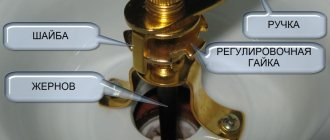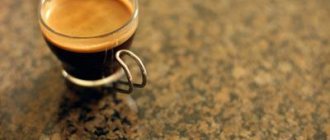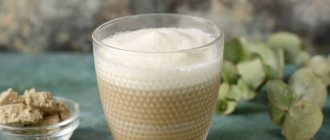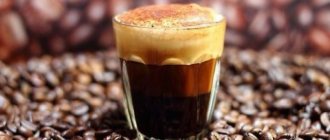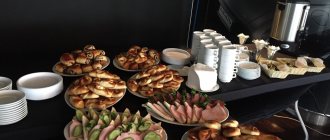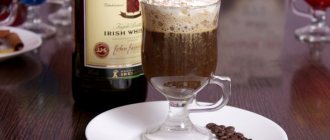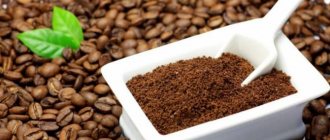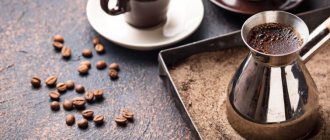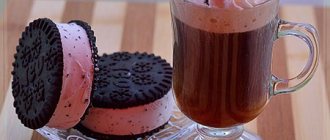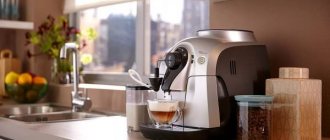Choosing grains
Despite the huge variety of coffee blends, you can most often find two of the most popular varieties on sale - Arabica and Rabusta.
- Arabica is valued for the rich aroma produced by grains rich in acids, essential oils and sugar.
- Rabusta is a little faded compared to Arabica, but has a high concentration of caffeine with a characteristic bitterness.
When choosing coffee beans, you first need to pay attention to the packaging. The bag must be airtight, with well-sealed corners and have a release valve. It may look like a round embossed impression with a hole. The special design of the valve ensures the release of carbon dioxide and protection from the ingress of oxygen, which can literally “age” the coffee and make the drink rancid.
Simple criteria for evaluating packaged grain:
- the aroma should be bright and “rich”;
- uniform roasting (best achieved by processing with a stream of hot air);
- all grains must be the same size and color;
- no visible defects (broken or split fragments).
Important! The roasting and packaging period should not exceed 4 months, otherwise there is a risk of getting a drink with weak taste.
Types of grinding
It is important to determine the grind time and size for different coffee preparation methods. A professional barista characterizes the grinding of beans into 4 basic options.
- Ultrafine, or coffee dust, means maximum friction to produce a light powder that leaves a bright mark on your fingers. This fraction is only suitable for classic brewing of oriental coffee in Turks. The best drink will be in a copper container with an inner layer of silver, which will retain all the aromas. A budget coffee grinder produces a fine grind in about 20 seconds. If the knives are not sharp enough, it is better to stop the device for half a minute so as not to overheat the grains and repeat the cycle for another 10 seconds.
- A fine grind can be achieved in approximately 15 seconds. It is designed for an espresso machine or geyser coffee maker with a fine filter. To judge the gravity of the coffee concentrate, it is best to drink the finished small cup immediately after it is ready, as at this point it will be at an ideal temperature of 75-80 degrees.
- Medium grind is intended for brewing in an Aeropress (a new method that has existed for about 10 years, means manually smoothly squeezing out powder diluted with boiling water in a special metal cylinder) or pourover (using a funnel with grooves and a filter, through which the powder with boiling water slowly flows into the lower container ).
- Coarse grinding is used for preliminary tasting or when brewing coffee through a French press (a glass teapot with a rod that, 4-5 minutes after brewing the powder with boiling water, can be slowly lowered to obtain a finished drink).
It is important to remember that when brewing coffee by hand without an open flame, all utensils must be rinsed with boiling water. Also, the aroma will develop better if the drink is poured into a warm cup.
Some coffee lovers warm the beans a little before grinding so that the aroma develops better.
Adviсe
Do not forget that you should not use electrical appliances for a long time for purposes other than their intended purpose; coffee beans are strong and can damage equipment. After use, devices should be washed thoroughly. Use them carefully and only as a last resort.
Both bean and ground coffee must be stored under special conditions so that it does not lose its properties: sealed storage in a cool place without light, low humidity. Ground coffee retains its properties in the correct packaging for a week, but it is better to store coffee in beans.
Remember that it is better to grind your coffee before using it. In this case, you get delicious and aromatic coffee.
Types of coffee grinders
The taste of coffee is born in the coffee grinder, so the choice of the kitchen appliance we are considering should be approached with particular seriousness. There are three types of coffee grinders on the market, differing in appearance and control method:
- knife (rotary) type;
- millstone;
- manual.
The most common models are rotary-type devices; coffee is ground using rotary knives that rotate at high speed, crushing the aromatic beans. In this case, regulation of the degree of grinding depends on the duration of action of the rotary knives. That is, the more they rotate, the finer the grind. The main disadvantage of this method is the inhomogeneity of grinding. The capacity of knife cutlery is usually no more than 120 g.
Millstones use conical or cylindrical millstones. They function similar to a mill - the grains, falling between the millstones, are crushed and ground into small particles. The degree of grinding is independently regulated and depends on the distance between the millstones. In this case, the degree of grinding is quite uniform. The capacity of these models is up to 300 g of coffee beans. Among all coffee grinders, this type of device is the most popular.
The main advantage that distinguishes a burr coffee grinder from a rotary one is the presence of a container for ready-made ground coffee.
A manual coffee grinder is a great way to get the required portion of fresh, well-ground coffee. The manual version of the device consists of two millstones, one of which is attached to the bottom, and the second is rotated by a handle. The advantage of a coffee grinder is that you cannot “burn” the coffee in it. Pour in the beans, turn the handle and in 15-20 minutes you get ready-made coffee powder, which is poured into a specially designed container.
Advice. Do not use a coffee grinder to grind other foods to avoid introducing additional odors.
Which coffee grind is best for a carob coffee maker?
Grinding is the third parameter that is important when purchasing coffee beans for espresso. Ideally, you need to grind them right before brewing, but you can buy ready-made powder of the desired degree of grinding:
- ultra-fine (“to dust”) – crushed grains are similar in particle size to ground cinnamon;
- fine espresso – particles the size of grains of salt;
- thin - like coarsely ground powdered sugar;
- medium – the size of sugar grains;
- coarse – like coarse sea salt.
What kind of coffee grind is needed for a carob coffee maker?
When interacting with hot water, extraction occurs, that is, “washing out” of the essential oils, caffeine and other compounds contained in the grains that create the characteristic taste. In the case of espresso, if the grind is too coarse, the coffee will be under-extracted, only acids will have time to brew in it, and the drink will turn out watery and unaromatic. If the grind is too fine, the coffee will be over-extracted and will be bitter with an unpleasant burnt aftertaste. When choosing which coffee is best for a carob coffee maker, choose a medium grind. Then the drink will not have a burnt smell, it will retain moderate richness and fully reveal its taste.
It is also worth considering that the finer the grind, the faster the particles are extracted. But different substances do not dissolve at the same time, so it is important to track the stages of extraction, each of which lasts approximately 8-10 seconds when preparing espresso:
- release of “sourness” from Arabica beans;
- extraction of substances with sweet, fruity and chocolate flavors;
- digestion of tannins and caffeine, which increase the bitterness of the drink.
The finer the grains are ground, the faster the third stage will begin, and it is important to stop it in time so that the drink does not spoil.
Instructions for grinding beans
How to properly grind coffee in an electric coffee grinder? To do this, you must follow the following procedure:
- Prepare a coffee grinder.
- Pour grains into it.
- Turn on the device.
- Record the time: 10 seconds – coarse grind, 13 seconds – medium; 15-20 seconds – fine and more than 30 seconds – ultra-fine.
- Open the lid and pour out the ground grains.
Advice! When using a coffee grinder with a small volume of beans, you can slightly rock the device so that the knives grind the raw materials evenly.
If you don't have a coffee grinder
If grinding coffee beans and preparing an aromatic drink occurs rarely, then you may not have a specialized coffee grinder in your kitchen. For one-time cooking, you can use improvised means or other kitchen aids.
- An electric meat grinder with a spice attachment (if the grinding is uneven, you can repeat the process twice).
- A blender with a lid and durable blades (if the set does not include a grinder), but the body will need to be turned or shaken for even grinding.
- Using a regular stone mortar or a manual spice mill, having thoroughly washed the tools beforehand so that there are no foreign odors left that could spoil the taste of the drink.
- Using a hammer or rolling pin on a kitchen board, pour the grains into a disposable ziplock bag.
Such methods are suitable as emergency methods, but it is almost impossible to regulate the grinding quality without a coffee grinder. Therefore, the grains will be crushed unevenly.
Other ways to get coffee beans ground
There are cases when anyone can find themselves without a coffee grinder, and it is not possible to grind beans mechanically. At such times, other kitchen appliances will do.
- Kitchen blender with bowl.
- Food processor.
- Immersion kitchen blender.
In addition to mechanical methods, manual methods can be used. You need to be patient and strong.
- Grind the coffee beans using a mortar and pestle.
- Crush the grains using a large flat knife and cutting board.
- Grinding grains using a rolling pin, a bag and a board.
- Crushing grains using a hammer, bag and cutting board.
- Grind the grains in a manual meat grinder.
Terms and rules for storing ground coffee
To always be able to brew high-quality coffee, it is important to adhere to the rules for purchasing roasted beans. If it is possible to order raw materials for two to three days of roasting in a sealed ziplock bag, then such grains can be safely ground and cooked within the next month. The condition will retain maximum aroma and will not oxidize under the influence of oxygen when opened for a short time.
Important! Gourmets recommend not grinding beans “in reserve,” since when the beans are destroyed during grinding, the coffee oil evaporates very quickly, even if the storage container has a tight rubberized lid.
The correct solution would be to do a full cycle of preparing the drink, which will begin with grinding and end with brewing.
Rules: how to grind coffee in a coffee grinder
The process of preparing a drink from grains is simple, but it has its own rules and tricks. Having studied them, you can easily prepare a drink that will satisfy the taste of the most demanding coffee lover.
- You should not make extra coffee. The quality of ground raw materials deteriorates faster than when stored in grains.
- Decide on the type of grinding. The time of grinding and use of finished raw materials must comply with generally accepted standards.
- Take the required amount of grains. On average, one cup of the finished drink contains 2 tablespoons of grains.
The taste of the prepared powder will not deteriorate if it is sealed and placed in the refrigerator.
Important! Using a manual coffee grinder instead of an electric one requires more time and effort, but the beans do not overheat and the signature aroma of coffee is unique.
